
The Araliaceae is a family of flowering plants composed of about 43 genera and approximately 1500 species consisting of primarily woody plants and some herbaceous plants. The morphology of Araliaceae varies widely, but it is predominantly distinguishable based on its woody habit, tropical distribution, and the presence of simple umbels.

Ginseng is the root of plants in the genus Panax, such as Chinese ginseng, South China ginseng, and American ginseng, typically characterized by the presence of ginsenosides and gintonin.
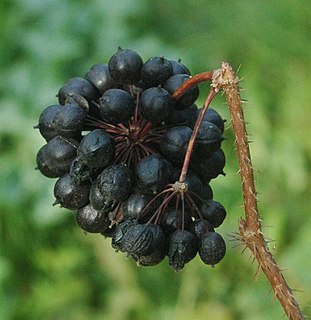
Eleutherococcus senticosus is a species of small, woody shrub in the family Araliaceae native to Northeastern Asia. It may be colloquially called devil's bush, Siberian ginseng, eleuthero, ciwujia, Devil's shrub, shigoka, touch-me-not, wild pepper, or kan jang. E. senticosus has a history of use in folklore and traditional Chinese medicine. Root extracts of E. senticosus are sold as a dietary supplement or cosmetic, usually under the name Siberian ginseng.
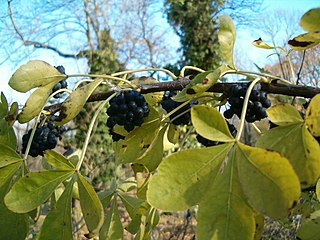
Eleutherococcus is a genus of 38 species of thorny shrubs and trees in the family Araliaceae. They are native to eastern Asia, from southeast Siberia and Japan to the Philippines and Vietnam. 18 species come from China, from central to western parts.
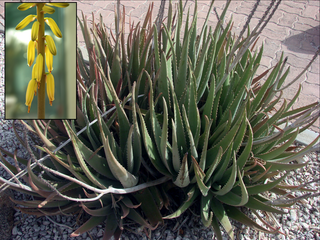
Aloe vera is a succulent plant species of the genus Aloe. An evergreen perennial, it originates from the Arabian Peninsula, but grows wild in tropical, semi-tropical, and arid climates around the world. It is cultivated for agricultural and medicinal uses. The species is also used for decorative purposes and grows successfully indoors as a potted plant.
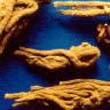
Angelica sinensis, commonly known as dong quai or female ginseng, is a herb belonging to the family Apiaceae, indigenous to China. Angelica sinensis grows in cool high altitude mountains in China, Japan, and Korea. The yellowish brown root of the plant is harvested in the fall and is a well-known Chinese medicine which has been used for thousands of years.

Zanthoxylum is a genus of about 250 species of deciduous and evergreen trees, shrubs and climbers in the family Rutaceae that are native to warm temperate and subtropical areas worldwide. It is the type genus of the tribe Zanthoxyleae in the subfamily Rutoideae. Several of the species have yellow heartwood, to which their generic name alludes.

The genus Mus or typical mice refers to a specific genus of muroid rodents, all typically called mice. However, the term mouse can also be applied to species outside of this genus.

Aralioideae is a subfamily of flowering plants contains around 50 recognized genera. These include the genus Panax, to which ginseng belongs. Other notable species are the Angelica-tree, the devil's club, or common ivy.
Peters' mouse is a species of rodent in the family Muridae. It is found in Benin, Cameroon, Central African Republic, Republic of the Congo, Democratic Republic of the Congo, Ivory Coast, Equatorial Guinea, Ethiopia, Gabon, Ghana, Guinea, Kenya, Liberia, Nigeria, Sierra Leone, Togo, and Uganda. Its natural habitats are subtropical or tropical dry forests and dry savanna.

Helicia is a genus of 110 species of trees and shrubs, constituting part of the plant family Proteaceae. They grow naturally in rainforests throughout tropical South and Southeast Asia, including India, Sri Lanka, Indochina, Peninsular Malaysia to New Guinea and as far south as New South Wales.

Eleutherococcus nodiflorus, also known as Acanthopanax gracilistylus, is deciduous plant with dark blue berries. It is considered a medicinal herb with significant effects. A widely used Chinese plant, it is in the family Araliaceae, and mainly grows at an altitude of around 3000 m. It is also found in Gaoligongshan Nature Reserve in Yunnan Province, China. It is widely distributed in China and has been used as a life-saving medicine against severe cases of paralysis, arthritis and liver disease; several experiments were carried out in 2003.
Eleutherococcus brachypus is a species of flowering plant in the family Araliaceae. It is endemic to China, where it occurs in scrub fields and roadsides on mountain slopes in Gansu, Ningxia, and Shaanxi provinces.
Eumetriochroa araliella is a moth of the family Gracillariidae. It is found in Mie, Nara, Fukuoka, Kagoshima prefectures, Japan.
Oncotylus setulosus is a species of plant bugs belonging to the family Miridae, subfamily Phylinae. It is found in Austria, Bulgaria, Czech Republic, France, Germany, Hungary, Moldova, Romania, Slovakia, Spain, Ukraine, and all states of former Yugoslavia.
Ptycholoma micantana is a species of moth of the family Tortricidae. It is found in China (Heilongjiang), North Korea and Russia. The habitat consists of fir broad-leaved forests, cedar broad-leaved forests and gardens.

Chengiopanax sciadophylloides is a flowering tree in the family Araliaceae native to Japan. Previously included in the genus Eleutherococcus, it is distinguished from other members of that genus by not having spines or prickles and ITS sequence data confirmed the separation.

Saihanba National Forest Park is a national forest park located in Weichang Manchu and Mongol Autonomous County, Chengde, Hebei, China, with Inner Mongolian Plateau standing in the northwest, covering an area of 200.29-square-kilometre (77.33 sq mi). Established in 1962, this is a multifunctional botanical park integrating scientific research, plant species collection and display as well as tourism. Saihanba is often called "the Green Lung of north China".

Eleutherococcus spinosus is a species of flowering shrub in the ginseng family (Araliaceae). It native to Japan, where it is common species found on the island of Honshu south of Iwate Prefecture. Its natural habitat is in areas of forest edges.
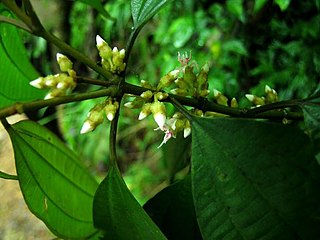
Blastus is a genus of plants in the family Melastomataceae. Species can be found in: Japan, China, Indo-China and west Malesia.














